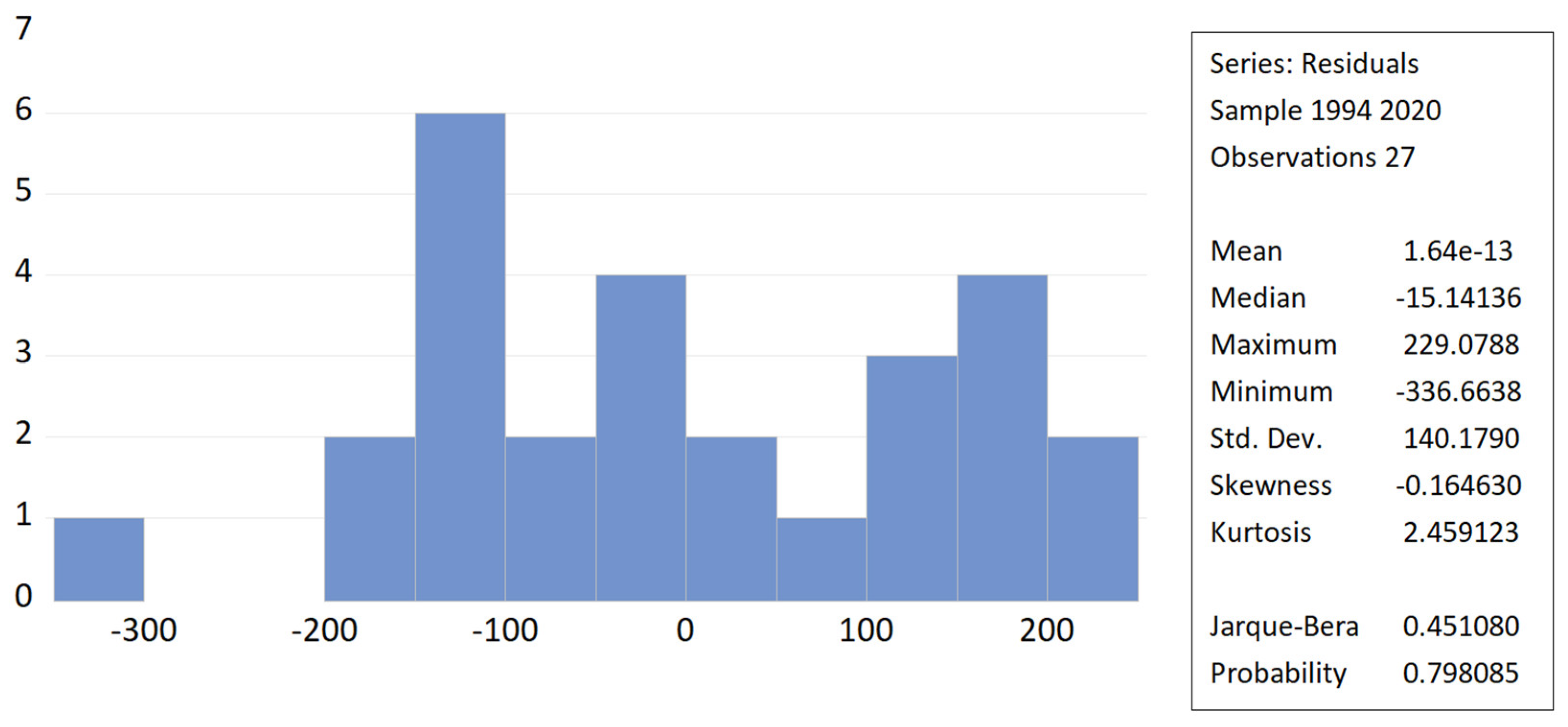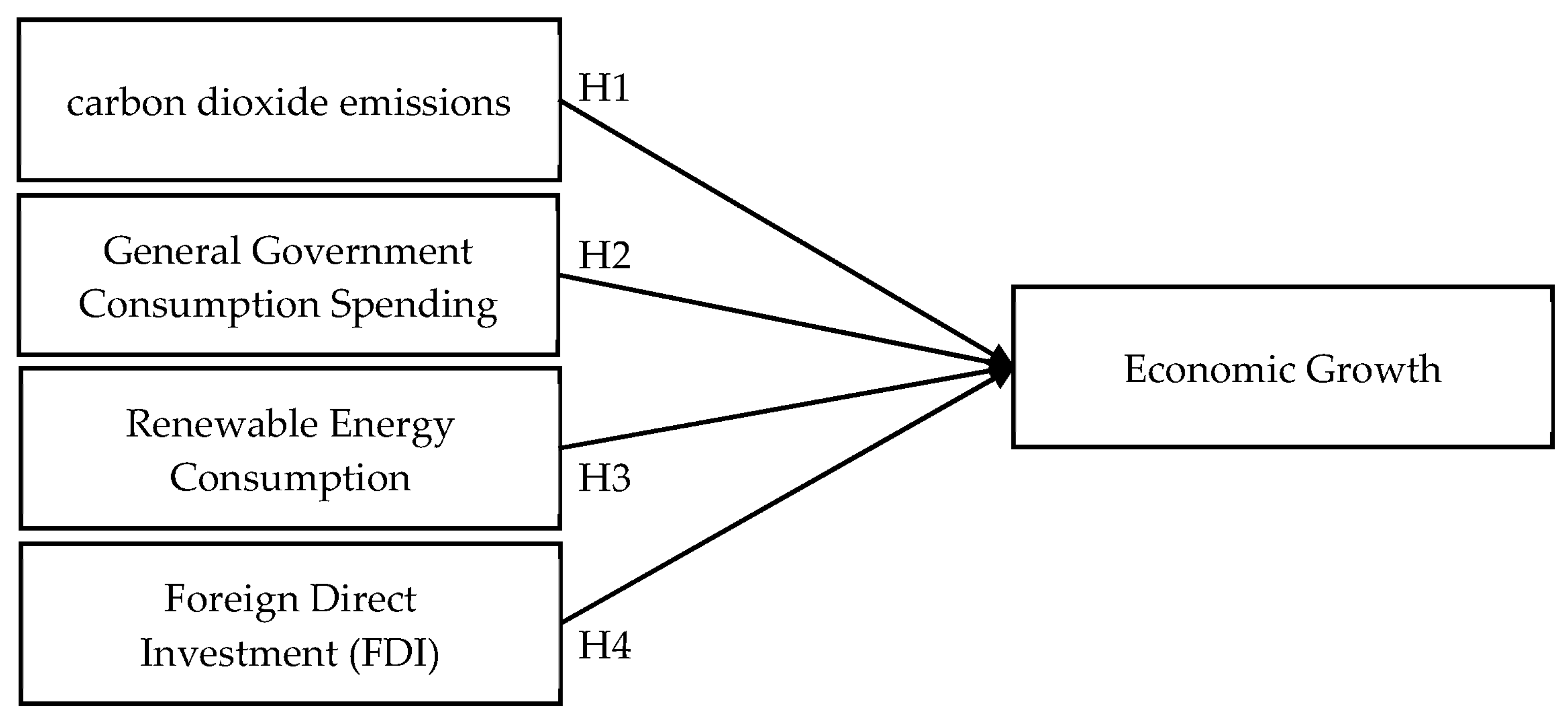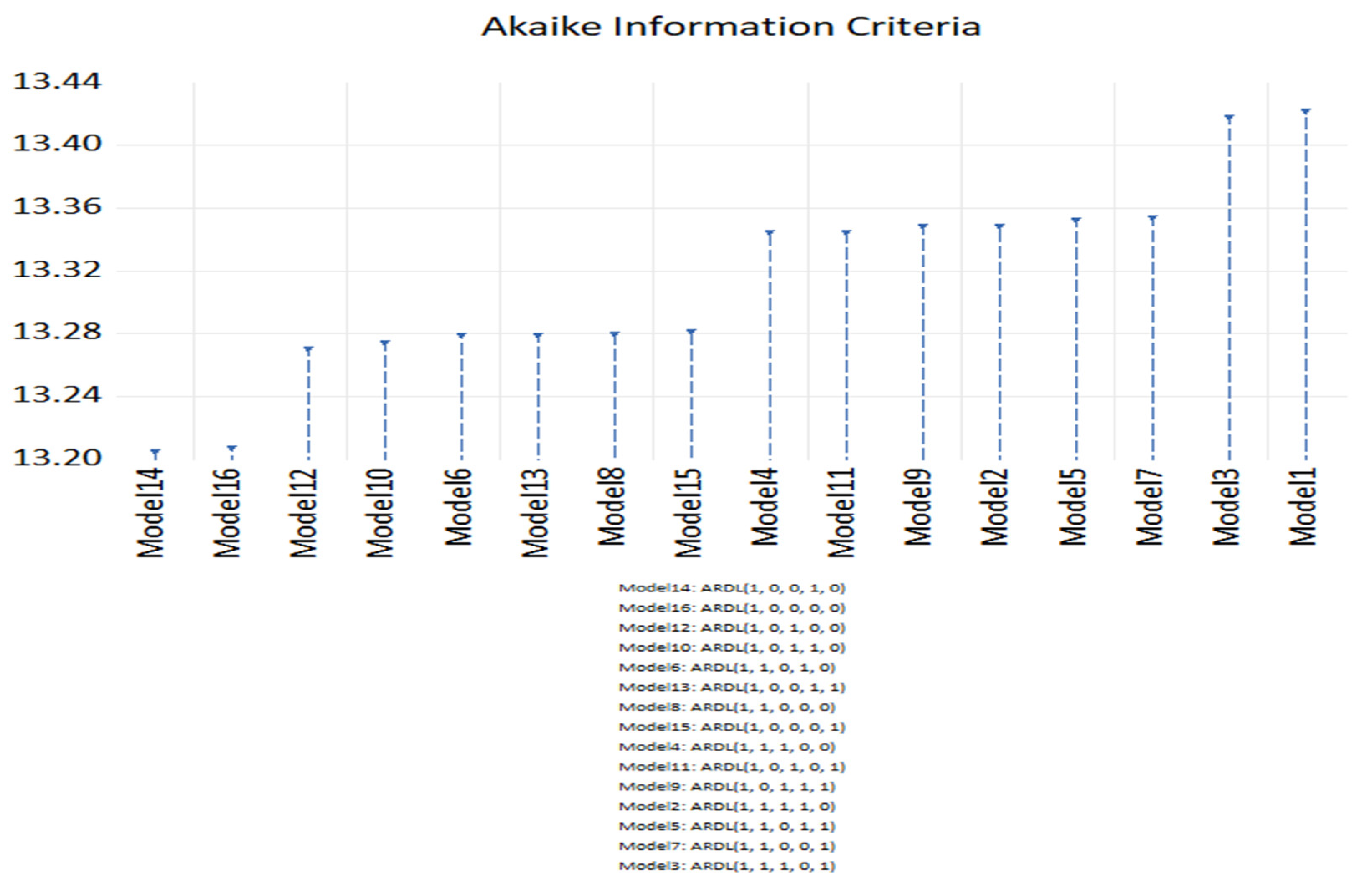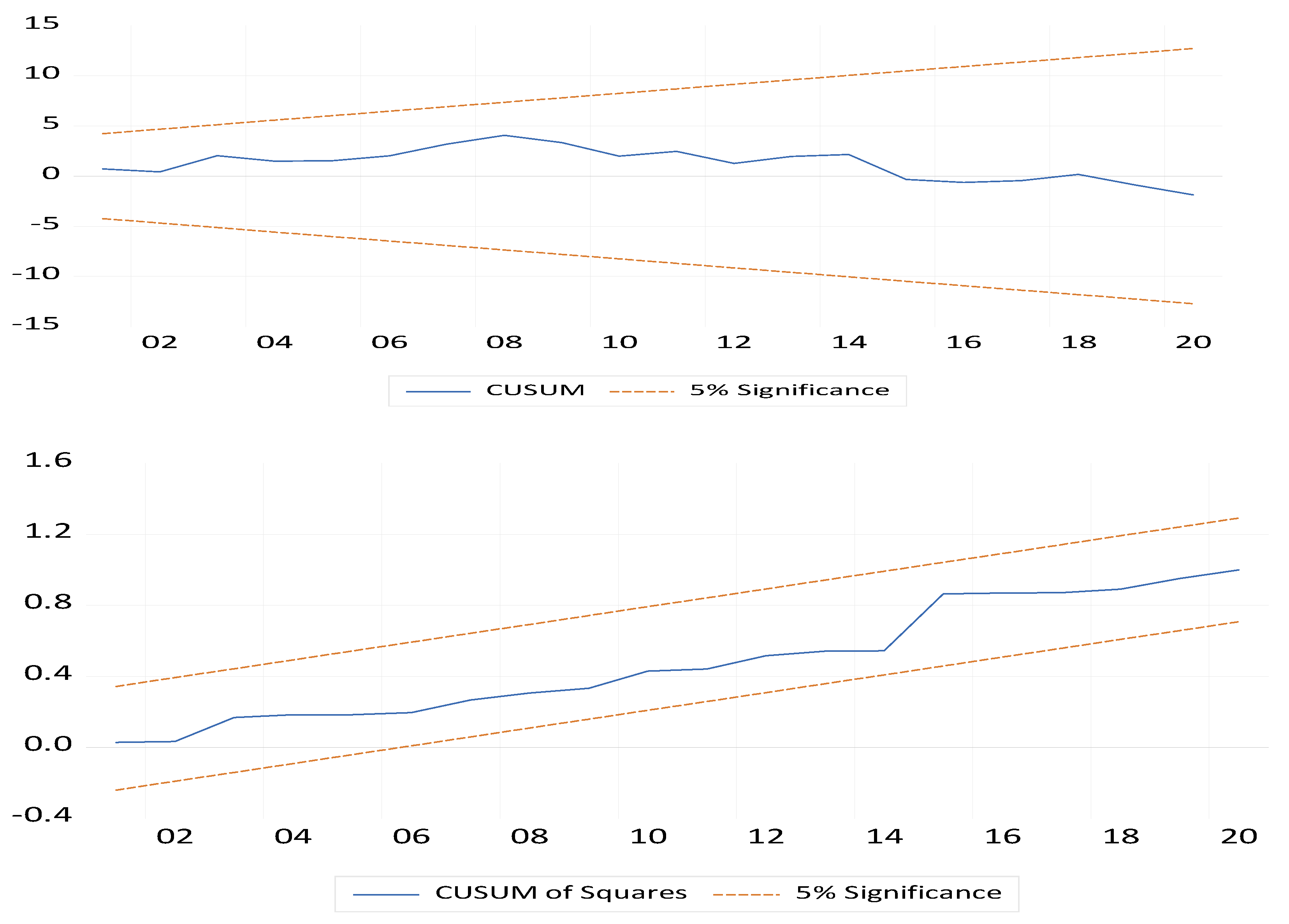Through the ARDL Approach: Is There a Nexus Between Renewable Energy Consumption, Economic Growth, and Foreign Direct Investment in the Moroccan Context?
Abstract
1. Introduction
2. Literature Review
2.1. Research Gap
2.2. Justification of Choice of Variables
- ➢
- FDI → economic growth (+)
- ▪
- The underlying rationale is that foreign direct investment encourages both capital accumulation and skill transfer, thereby accelerating the technological catch-up process and fostering sustainable economic development.
- ➢
- REC → economic growth (+)
- ▪
- In other words, maximizing the use of renewable energy boosts productivity while minimizing reliance on external energy sources.
- ➢
- CO2 → economic growth (+/−)
- ▪
- This theme reflects an ambiguous relationship that highlights the balance between environmental preservation and economic progress.
- ➢
- GGCS → economic growth (−)
- ▪
- This concept suggests that public spending can potentially reduce economic efficiency.
3. Data and Methodology
4. Results of the Study
4.1. Descriptive Statistics
4.2. Unit Root Tests
4.3. Co-Integration Bound Test and Optimal Lag
4.4. Long-Run, Short-Run, and Adjustment Dynamics
4.5. Test of Heteroscedasticity and CUSUM of Squares
5. Discussion
Policy Recommendations
6. Conclusions
Limitations and Future Research
Author Contributions
Funding
Institutional Review Board Statement
Informed Consent Statement
Data Availability Statement
Acknowledgments
Conflicts of Interest
References
- Fikri, Y.; Rhalma, M. Effect of CO2 Emissions, Renewable Energy Consumption and General Government Final Consumption Spending on Moroccan Economic Growth: ARDL Approach. Int. J. Energy Econ. Policy 2024, 14, 575–581. [Google Scholar] [CrossRef]
- Al Samman, H.; Akkaş, E. How Do the Crises of Falling Oil Prices and COVID-19 Affect Economic Sectors in the Rentier Economies? Evidence from the GCC Countries. J. Econ. Cult. Soc. 2022, 65, 105–127. [Google Scholar] [CrossRef]
- Swe, H.Y. Analysis of Long Run and Short Run Relationship between Myanmar’s Economy and Infrastructure-Social Investment; Myanmar. 2019. Available online: https://scispace.com/papers/analysis-of-long-run-and-short-run-relationship-between-3222o7lrz2 (accessed on 1 August 2025).
- Batool, K.; Akbar, M. Influence of Infrastructure Development with Its Sub-Sectors on Economic Growth in Selected Asian Countries: An Empirical Analysis Using DOLS and FMOLS Approaches. Pak. J. Humanit. Soc. Sci. 2023, 11, 2236–2253. [Google Scholar] [CrossRef]
- Harbal, A.; Khihel, F. The Impact of Interactions Between Public and Private Investment on Improving the Business Climate in Morocco; International Journal of Accounting, Finance, Auditing, Management and Economics. 2023. Available online: https://ijafame.org/index.php/ijafame/article/view/858/857 (accessed on 2 August 2025).
- Meltzer, A.H. Keynes’s General Theory: A Different Perspective. J. Econ. Lit. 1981, 19, 34–64. [Google Scholar]
- El Asli, H.; Hamid, L.; Zineb, A.; Mohamed, A. Impact of Human Capital, Economic Factors, Energy Consumption, and Urban Growth on Environmental Sustainability in Morocco: An ARDL Approach. Int. J. Energy Econ. Policy 2024, 14, 656–668. [Google Scholar] [CrossRef]
- Bouyghrissi, S.; Berjaoui, A.; Khanniba, M. The Nexus between Renewable Energy Consumption and Economic Growth in Morocco. Environ. Sci. Pollut. Res. 2021, 28, 5693–5703. [Google Scholar] [CrossRef]
- Kraft, T.; Valdés, L.; Zheng, Y. Supply Chain Visibility and Social Responsibility: Investigating Consumers’ Behaviors and Motives. Manuf. Serv. Oper. Manag. 2018, 20, 617–636. [Google Scholar] [CrossRef]
- Kraft, T.; Valdés, L.; Zheng, Y. Consumer Trust in Social Responsibility Communications: The Role of Supply Chain Visibility. Prod. Oper. Manag. 2022, 31, 4113–4130. [Google Scholar] [CrossRef]
- Chen, C.-L.; Pinar, M.; Stengos, T. Renewable Energy Consumption and Economic Growth Nexus: Evidence from a Threshold Model. Energy Policy 2020, 139, 111295. [Google Scholar] [CrossRef]
- Taher, H. Renewable Energy Consumption Impact on the Lebanese Economy. Int. J. Energy Econ. Policy 2017, 7, 144–148. [Google Scholar]
- Begum, R.A.; Sohag, K.; Abdullah, S.M.S.; Jaafar, M. CO2 Emissions, Energy Consumption, Economic and Population Growth in Malaysia. Renew. Sustain. Energy Rev. 2015, 41, 594–601. [Google Scholar] [CrossRef]
- Raihan, A.; Begum, R.A.; Said, M.N.M.; Pereira, J.J. Relationship between Economic Growth, Renewable Energy Use, Technological Innovation, and Carbon Emission toward Achieving Malaysia’s Paris Agreement. Environ. Syst. Decis. 2022, 42, 586–607. [Google Scholar] [CrossRef]
- Ren, X.; An, Y.; He, F.; Goodell, J.W. Do FDI Inflows Bring Both Capital and CO2 Emissions? Evidence from Non-Parametric Modelling for the G7 Countries. Int. Rev. Econ. Financ. 2024, 95, 103420. [Google Scholar] [CrossRef]
- Bengoa, M.; Sanchez-Robles, F.D.I. Economic Freedom, and Growth: New Evidence from Latin America. Eur. J. Polit. Econ. 2003, 19, 529–545. [Google Scholar] [CrossRef]
- Zhang, D.; Mohsin, M.; Rasheed, A.K.; Chang, Y.; Taghizadeh-Hesary, F. Public Spending and Green Economic Growth in BRI Region: Mediating Role of Green Finance. Energy Policy 2021, 153, 112256. [Google Scholar] [CrossRef]
- Connolly, M.; Li, C. Government Spending and Economic Growth in the OECD Countries. J. Econ. Policy Reform. 2016, 19, 386–395. [Google Scholar] [CrossRef]
- Pedroni, P. Panel Cointegration: Asymptotic and Finite Sample Properties of Pooled Time Series Tests with an Application to the PPP Hypothesis. Econ. Theory 2004, 20, 597–625. [Google Scholar] [CrossRef]
- Josheski, D.; Lazarov, D.; Koteski, C. Cobb-Douglas Production Function Revisited, VAR and VECM Analysis and a Note on Fischer/Cobb-Douglass Paradox. SSRN Electron. J. 2011. [Google Scholar] [CrossRef]
- Romer, P.M. Increasing Returns and Long-Run Growth. J. Political Econ. 1986, 94, 1002–1037. [Google Scholar] [CrossRef]
- Lucas, R.E., Jr.; Prescott, E.C. Investment under Uncertainty. Econometrica 1971, 39, 659–681. [Google Scholar] [CrossRef]
- Chester, D. The Economics of Public Utility Regulation. J. Political Econ. 1941, 49, 108–112. [Google Scholar]
- Yergin, D. Ensuring Energy Security. Foreign Aff. 2006, 85, 69–82. [Google Scholar] [CrossRef]
- Sachs, J.D. The Age of Sustainable Development; Columbia University Press: New York, NY, USA, 2015. [Google Scholar]
- Porter, M.E.; van der Linde, C. Toward a New Conception of the Environment-Competitiveness Relationship. J. Econ. Perspect. 1995, 9, 97–118. [Google Scholar] [CrossRef]
- Grossman, G.M.; Krueger, A.B. Environmental Impacts of a North American Free Trade Agreement; National Bureau of Economic Research: Cambridge, UK, 1991. [Google Scholar]
- Panayotou, T. Empirical Tests and Policy Analysis of Environmental Degradation at Different Stages of Economic Development; International Labour Organization: Geneva, Switzerland, 1993. [Google Scholar]
- Dinda, S. Environmental Kuznets Curve Hypothesis: A Survey. Ecol. Econ. 2004, 49, 431–455. [Google Scholar] [CrossRef]
- Dasgupta, S.; Laplante, B.; Wang, H.; Wheeler, D. Confronting the Environmental Kuznets Curve. J. Econ. Perspect. 2002, 16, 147–168. [Google Scholar] [CrossRef]
- Stern, D.I. The Rise and Fall of the Environmental Kuznets Curve. World Dev. 2004, 32, 1419–1439. [Google Scholar] [CrossRef]
- Carson, R.T. The Environmental Kuznets Curve: Seeking Empirical Regularity and Theoretical Structure. Rev. Environ. Econ. Policy 2010, 4, 3–23. [Google Scholar] [CrossRef]
- Friedman, M. The Limitations of Tax Limitation. Policy Rev. 1978, 5, 7–14. [Google Scholar]
- Barro, R.J. Government Spending in a Simple Model of Endogenous Growth. J. Political Econ. 1990, 98, S103–S125. [Google Scholar] [CrossRef]
- Aschauer, D.A. Is Public Expenditure Productive? J. Monet. Econ. 1989, 23, 177–200. [Google Scholar] [CrossRef]
- Grier, K.B.; Tullock, G. An Empirical Analysis of Cross-National Economic Growth, 1951–1980. J. Monet. Econ. 1989, 24, 259–276. [Google Scholar] [CrossRef]
- Devarajan, S.; Swaroop, V.; Zou, H. The Composition of Public Expenditure and Economic Growth. J. Monet. Econ. 1996, 37, 313–344. [Google Scholar] [CrossRef]
- Mankiw, N.G. A Quick Refresher Course in Macroeconomics. J. Econ. Lit. 1990, 28, 1645–1660. [Google Scholar]
- Pesaran, M.H.; Shin, Y. An Autoregressive Distributed Lag Modelling Approach to Cointegration Analysis; Department of Applied Economics, University of Cambridge: Cambridge, UK, 1995. [Google Scholar]
- Pesaran, M.H.; Shin, Y.; Smith, R.J. Bounds Testing Approaches to the Analysis of Level Relationships. J. Appl. Econom. 2001, 16, 289–326. [Google Scholar] [CrossRef]
- Barro, R.J.; Sala-i-Martin, X. Convergence. J. Political Econ. 1992, 100, 223–251. [Google Scholar] [CrossRef]
- Mankiw, N.G.; Romer, D.; Weil, D.N. A Contribution to the Empirics of Economic Growth. Q. J. Econ. 1992, 107, 407–437. [Google Scholar] [CrossRef]
- Stock, J.H.; Watson, M.W. A Simple Estimator of Cointegrating Vectors in Higher Order Integrated Systems. Econometrica 1993, 61, 783–820. [Google Scholar] [CrossRef]
- Schmidt, C.G.; Wuttke, D.A.; Ball, G.P.; Heese, H.S. Does Social Media Elevate Supply Chain Importance? An Empirical Examination of Supply Chain Glitches, Twitter Reactions, and Stock Market Returns. J. Oper. Manag. 2020, 66, 646–669. [Google Scholar] [CrossRef]
- Yule, G.U. Why Do We Sometimes Get Nonsense-Correlations between Time-Series? A Study in Sampling and the Nature of Time-Series. J. R. Stat. Soc. 1926, 89, 1–63. [Google Scholar] [CrossRef]
- Taher, H. The Impact of Government Expenditure, Renewable Energy Consumption, and CO2 Emissions on Lebanese Economic Sustainability: ARDL Approach. Environ. Econ. 2024, 15, 217–227. [Google Scholar] [CrossRef]
- Akaike, H. Canonical Correlation Analysis of Time Series and the Use of an Information Criterion. Math. Sci. Eng. 1976, 126, 27–96. [Google Scholar] [CrossRef]
- Wasserstein, R.L.; Lazar, N.A. The ASA Statement on P-Values: Context, Process, and Purpose. Am. Stat. 2016, 70, 129–133. [Google Scholar] [CrossRef]
- Saidi, K.; Omri, A. The Impact of Renewable Energy on Carbon Emissions and Economic Growth in 15 Major Renewable Energy-Consuming Countries. Env. Res. 2020, 186, 109567. [Google Scholar] [CrossRef]
- Banerjee, A.; Dolado, J.; Mestre, R. Error-Correction Mechanism Tests for Cointegration in a Single-Equation Framework. J. Time Ser. Anal. 1998, 19, 267–283. [Google Scholar] [CrossRef]
- Bera, A.K.; Jarque, C.M.; Lee, L.-F. Testing the Normality Assumption in Limited Dependent Variable Models. Int. Econ. Rev. 1984, 25, 563. [Google Scholar] [CrossRef]
- Bourbonnais, R. Prévision Des Ventes. Polycopié Du Produit Multimédia, Université Paris-Dauphine, Editor: Librairie Eyrolles—Paris 5e, France. 2001. Available online: https://moodle.luniversitenumerique.fr/pluginfile.php/4260/mod_resource/content/0/poly.pdf (accessed on 2 August 2025).
- Pigou, A.C. Keynes’ General Theory of Employment, Interest and Money. Economica 1936, 3, 115. [Google Scholar] [CrossRef]




| Variables | Abbreviations |
|---|---|
| GDP per capita | GDP |
| Economic growth | EG |
| Foreign direct investment | FDI |
| Carbon dioxide emissions | CO2 emissions |
| General government consumption spending | GGCS |
| Renewable energy consumption | REC |
| Variables | Definition |
|---|---|
| GDP | GDP per capita as proxy of economic growth |
| FDI | Foreign direct investment, net inflows (% of GDP) |
| CO2 emissions | Carbon dioxide emissions (metric tons per capita) |
| GGCS | General government consumption spending of GDP |
| REC | Renewable energy consumption of total final energy consumption |
| Descriptive Statistics Criteria | GDP | FDI | CO2 | GGCS | REC |
|---|---|---|---|---|---|
| Mean | 2460.017 | 2.197913 | 1.446758 | 16.99462 | 14.70143 |
| Median | 2592.318 | 2.104375 | 1.471459 | 16.90606 | 15.03000 |
| Maximum | 3498.583 | 6.444129 | 1.955308 | 19.40499 | 22.97000 |
| Minimum | 1217.429 | 0.663931 | 0.991096 | 14.30467 | 10.45000 |
| Std. Dev. | 833.8227 | 1.209715 | 0.290854 | 1.286759 | 3.290203 |
| Skewness | −0.153952 | 1.500277 | −0.054651 | −0.034499 | 0.413372 |
| Kurtosis | 1.311911 | 6.432709 | 1.623676 | 2.109225 | 2.587370 |
| Jarque–Bera | 3.435192 | 24.25129 | 2.223916 | 0.931281 | 0.996063 |
| Probability | 0.179497 | 0.000005 | 0.328914 | 0.627733 | 0.607726 |
| Sum | 68,880.49 | 61.54156 | 40.50922 | 475.8494 | 411.6400 |
| Sum Sq. Dev. | 18,772,027 | 39.51206 | 2.284099 | 44.70524 | 292.2867 |
| Observations | 28 | 28 | 28 | 28 | 28 |
| Variable | Series | p-Value | Series in First Difference | p-Value | ||
|---|---|---|---|---|---|---|
| Test Statistic | Dickey–Fuller Critical Value (5%) | Test Statistic | Dickey–Fuller Critical Value (5%) | |||
| GDP per capita | 1.631693 | −1.953858 | 0.9717 | −3.804519 | −1.954414 | 0.0005 |
| FDI | −0.842543 | −1.954414 | 0.3413 | −12.38976 | −1.954414 | 0.0000 |
| CO2 emissions | 0.031091 | 3.217145 | 0.0037 | −4.663002 | −4.663002 | 0.0000 |
| GGCS | 0.173015 | −1.953858 | 0.7285 | −8.329758 | −1.954414 | 0.0000 |
| REC | −0.996210 | −1.953858 | 0.2782 | −4.993035 | −1.954414 | 0.0000 |
| Number of Lags | Final Prediction Error | Akaike Information Criterion | Schwarz Bayesian Information Criterion | Hannan–Quinn Information Criterion |
|---|---|---|---|---|
| 0 | 27339.63 | 24.40529 | 24.64723 | 24.47496 |
| 1 | 662.4384 * | 20.64299 * | 22.09464 * | 21.06101 * |
| 2 | 888.8118 | 20.69570 | 23.35706 | 21.46208 |
| Sample | 1993–2020 | |||
|---|---|---|---|---|
| Observations | 27 | |||
| R-squared | 0.970246 | |||
| Adj R-squared i | 0.961320 | |||
| Prob > F | 0.000000 | |||
| Log likelihood | −171.2607 | |||
| Variables | Coefficient | Std. Err. | T | p > |t| |
| GDP (−1) | 0.807973 | 0.152736 | 5.289983 | 0.0000 |
| FDI | 11.39506 | 27.39401 | 0.415969 | 0.6819 |
| CO2 emissions | 781.0957 | 443.5516 | 1.761003 | 0.0935 |
| GGCS | −100.1320 | 40.01883 | −2.502123 | 0.0211 |
| REC | 14.38036 | 15.47447 | 0.929296 | 0.929296 |
| REC (−1) | 47.81629 | 38.03048 | 1.257315 | 0.2231 |
| C (constant) | 53.74452 | 773.3257 | 0.069498 | 0.9453 |
| Short-Run (SR) | ||||
|---|---|---|---|---|
| Variables | Coefficient | Std. Err. | T | p > |t| |
| FDI | 11.39506 | 27.39401 | 0.415969 | 0.6819 |
| CO2 emissions | 781.0957 | 443.5516 | 1.761003 | 0.0935 |
| GGCS | −52.31575 | 37.66135 | −1.389110 | 0.1801 |
| REC | 14.38036 | 15.47447 | 0.929296 | 0.3638 |
| C (constant) | 53.74452 | 773.3257 | 0.069498 | 0.9453 |
| Long-Run (LR) | ||||
| Variables | Coefficient | Std. Err. | T | p > |t| |
| FDI | 59.34094 | 162.0297 | 0.366235 | 0.7180 |
| CO2 emissions | 4067.635 | 1466.302 | 2.774078 | 0.0117 |
| GGCS | −272.4396 | 288.1414 | −0.945506 | 0.3557 |
| REC | 74.88719 | 110.7978 | 0.675890 | 0.5069 |
| C (constant) | 279.8800 | 4071.950 | 0.068734 | 0.9459 |
| ADJ | ||||
| Variables | Coefficient | Std. Err. | T | p > |t| |
| GDP per capita | −0.192027 | 0.045377 | −4.231785 | 0.0004 |
| F: 2.387734 | 27 Observations, 4 Variables | |||||
|---|---|---|---|---|---|---|
| F Test | 10% | 5% | 1% | |||
| I (0) | I (1) | I (0) | I (1) | I (0) | I (1) | |
| F | 2.2 | 3.09 | 2.56 | 3.49 | 3.29 | 4.37 |
| Source | Prob. Chi2 (14) | Df | p |
|---|---|---|---|
| Prob. F (6, 20) > Prob. chi2 (6) = 0.3111 | - | - | - |
| Heteroskedasticity | 0.3509 | 27 | 0.8280 |
Disclaimer/Publisher’s Note: The statements, opinions and data contained in all publications are solely those of the individual author(s) and contributor(s) and not of MDPI and/or the editor(s). MDPI and/or the editor(s) disclaim responsibility for any injury to people or property resulting from any ideas, methods, instructions or products referred to in the content. |
© 2025 by the authors. Licensee MDPI, Basel, Switzerland. This article is an open access article distributed under the terms and conditions of the Creative Commons Attribution (CC BY) license (https://creativecommons.org/licenses/by/4.0/).
Share and Cite
Fikri, Y.; Talaat, R.; Shaheen, A.; Hassan, A.; Khataan, A. Through the ARDL Approach: Is There a Nexus Between Renewable Energy Consumption, Economic Growth, and Foreign Direct Investment in the Moroccan Context? Sustainability 2025, 17, 9762. https://doi.org/10.3390/su17219762
Fikri Y, Talaat R, Shaheen A, Hassan A, Khataan A. Through the ARDL Approach: Is There a Nexus Between Renewable Energy Consumption, Economic Growth, and Foreign Direct Investment in the Moroccan Context? Sustainability. 2025; 17(21):9762. https://doi.org/10.3390/su17219762
Chicago/Turabian StyleFikri, Yahya, Randa Talaat, Ahmad Shaheen, Ahmed Hassan, and Abdullah Khataan. 2025. "Through the ARDL Approach: Is There a Nexus Between Renewable Energy Consumption, Economic Growth, and Foreign Direct Investment in the Moroccan Context?" Sustainability 17, no. 21: 9762. https://doi.org/10.3390/su17219762
APA StyleFikri, Y., Talaat, R., Shaheen, A., Hassan, A., & Khataan, A. (2025). Through the ARDL Approach: Is There a Nexus Between Renewable Energy Consumption, Economic Growth, and Foreign Direct Investment in the Moroccan Context? Sustainability, 17(21), 9762. https://doi.org/10.3390/su17219762







